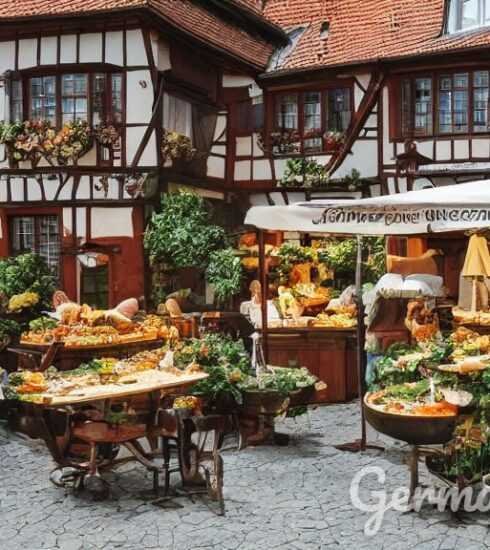Uncovering German Culinary Heritage: A Reviving Journey to Germanys Ancient Flavors
Embarking on the Culinary Journey to the Heart of Germany’s Forgotten Flavors
Germany, famously known worldwide for its beer, bratwurst, and pretzels, holds a culinary treasure trove readily waiting to be rediscovered. While the contemporary German gastronomical scene is dominated by the aforementioned staples, there exists an array of ancient, time-honored dishes and flavors that have been forgotten over time. This culinary journey is a quest to unearth, appreciate, and painstakingly revive delicious and extraordinary German culinary traditions.
Beyond the typical delights found in the beer gardens of Berlin or the fine-dining establishments of Frankfurt, lie forgotten but incredibly worthy German dishes. A compelling blend of history, heritage, and culinary genius, these gastronomic gems remind us of the great depth and diversity of German cuisine.
<h2<Rekindling the Love for German FoodIt’s not just about food; it’s about rekindling the love and connection for German cuisine through the exploration of authentic, long-forgotten recipes and ingredients. As we embark on this journey, be prepared to debunk mythologies surrounding German food, think beyond the ubiquitous sausages, and reveal wholesome, flavorful dishes. Our mission is to share delectable dishes whose flavors and recipes have been passed down through generations, providing a rich insight into Germany’s culinary heritage.
Ancient Recipes, New Sensations

Germany’s ancient recipes, dating back centuries, incorporates a variety of culinary traditions influenced by its neighbors, including France, Poland, and Austria. Many of these forgotten flavors integrate humble ingredients sourced directly from local farms, creating a sustainable and earthy dining experience.
Rediscovering these lost delicacies isn’t just about reliving history but creating a new sensation, a fresh perspective on the richness of German cuisine. Imagine biting into a hearty Sauerbraten, prepared using an age-old recipe from the heartlands of Rhineland, or savoring a subtly sweet Lebkuchen, identical to how Nuremberg bakers used to prepare back in the Middle Ages. The aromas and flavors in these time-tested recipes offer a tantalizing taste of historical Germany.
The Ingredients of Ancient German Cuisine
The allure of German’s forgotten flavors lies, in part, in their ingredients. Many dishes incorporate a range of locally sourced, sustainable ingredients that mirror the country’s rich agricultural heritage. They include:
- Rye: A grain frequently used in ancient German recipes, primarily in bread and beer.
- Garden vegetables: Common in ancient dishes like stew.
- Game meats: Used extensively in historical dishes, offering a robust palette of flavors.
- Wild herbs: Often added to bring about a distinct taste and aroma.

By using simple yet flavorful ingredients, our ancestors were able to create dishes that are both heartwarming and delicious.
<h3<Inspiration from Ancient Culinary ScrollsAncient German culinary scrolls would offer a wealth of knowledge and inspire us. Packed with insightful details about ingredients, cooking methods, and the cultural significance of dishes, these scrolls will be our tour guides on this enriching journey.
For illustrative purposes, the following are summaries of two such forgotten but worthy dishes:
Sauerbraten: A Traditional German Pot Roast

Sauerbraten, meaning ‘sour roast,’ is a hearty dish traditionally made with horse meat, though nowadays, beef is commonly used. Originating from the Rhineland region, sauerbraten was considered a festive dish typically prepared for special occasions. The meat is marinated for several days in a mixture of vinegar or wine, water, and a variety of herbs and spices before being slow-cooked to perfection. This practice provides the dish with its unique, unforgettable taste. Find more about this dish here.
Lebkuchen: Germany’s Oldest Christmas Cookie
Lebkuchen, often referred to as Germany’s oldest Christmas cookie, dates back to the Middle Ages. Hailing from the city of Nuremberg, these subtly sweet and aromatic cookies combine honey, nuts, and a variety of spices to create a warm, festive flavor. Nuremberg’s master-bakers guarded the lebkuchen recipe closely, a testament to its value and popularity. Today, modern interpretations of this cookie continue to fill German Christmas markets, but the ancient recipes offer their own unique charm. More details about Lebkuchen can be found here.
Embarking on this Timeless Culinary Quest
Being a part of this culinary journey isn’t just about understanding German cuisine; it’s about experiencing and interacting with history, culture, and the indomitable spirit of human creativity. It’s a voyage through gastronomical landscapes left untouched for centuries.
So buckle up, brace your taste buds, and join us on this incredible expedition of rediscovery – a journey to the heart of Germany’s forgotten flavors.






